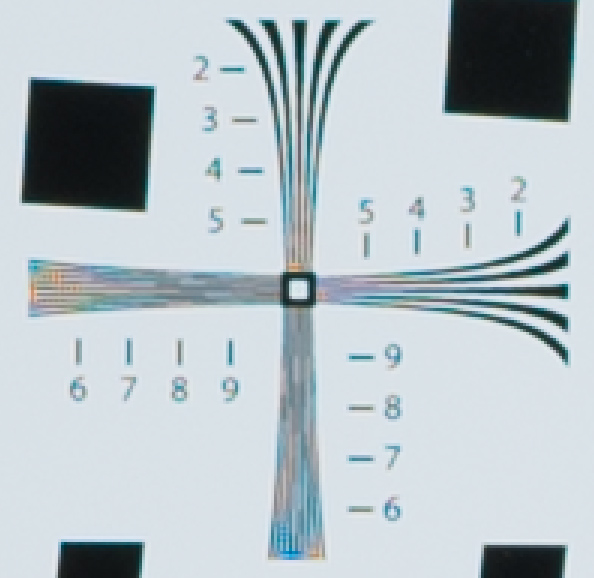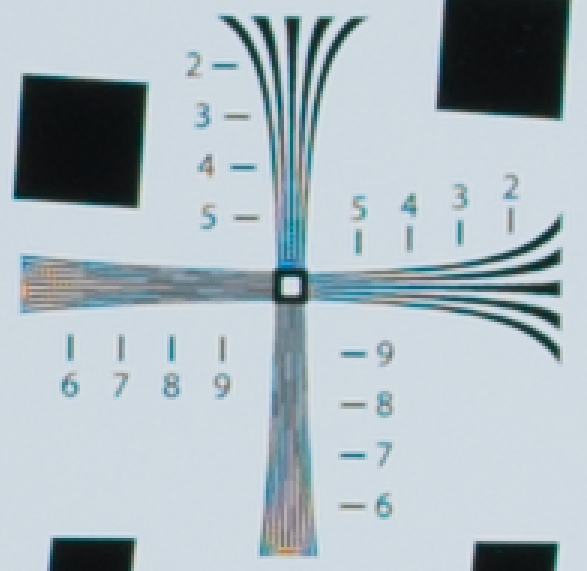The Sony a7R/55mm Sonnar testing with strobe illumination of the ISO 12233 target performed in the previous post got me worried. If the Sony’s shutter affects the sharpness of strobe-lit subjects with a normal focal length lens, would Nikon D800E mirror slap suffer the same fate?
I mounted an AF-S 58mm f/1.4G lens on the D800E, and screwed on the 9-stop Hoya ND filter. I installed the RRS D800E L-bracket on the camera, and clamped the camera to the Arca Swiss C1 Cube that was mounted to the RRS TVC-34L Versa Series 3 tripod. As in the previous post, the tripod stood on a vinyl-tile-over-concrete floor. The tripod didn’t move from its previous position, so the target size in the image was 58/55 = 105.45% of its size in the Sony images.
I lit the ISO 12233 target with two White Lightning 1600x strobes, set for a full dump. I set the ISO to 100, the shutter to 1/250, and focused manually. It was much harder with the Nikon than the Sony, due to a combination of the subsampled live view in the Nikon and the focus-by-wire operation of the Sony, which makes it much easies to make small changes to the in-focus plane.
Using a remote release, with the camera in landscape orientation, I banged off some shots with the shutter mode set to S. Then I changed the mode to MUP, and made some more exposures, this time waiting about five seconds after the mirror came up to trip the shutter. Finally, I set the shutter speed to five seconds, tripped the mirror, then the shutter, and manually fired the strobes about four seconds in to the exposure.
Then I mounted the camera in the portrait orientation, and did the whole thing again.
Here’s what I found, res’d up 3x using nearest neighbor.
In landscape orientation with the S shutter option:
In landscape orientation with the MUP shutter option:
In landscape orientation with manually-fired strobe:
In portrait orientation with the S shutter option:
In portrait orientation with the MUP shutter option:
In portrait orientation with manually-fired strobe:
First off, the Nikon pictures are sharper than the Sony ones. They ought to be a little sharper because the lens was about 5% longer, but that can’t explain this big a difference. Since the Sony lens was easier to focus accurately, the 58mm f/1.4 Nikkor is sharper on-axis at f/5.6 than the 55mm f/1.8 Sonnar, and/or there’s some focus shift upon stopping down in the Sony/Zeiss lens, since both were focused wide open.
The big surprise is the degradation of the mirror-up exposures over the ones that got the full effect of the mirror slap is very small, and both are not severely degraded with respect to the images with the delayed, manual strobe activation. The high quality of the mirror-slapped images is a surprise considering that the D800E’s mirror delivers a whack to a long telephoto about five times the size of the one caused by the a7R’s shutter.
As expected, the portrait S-mode image is not a sharp as the landscape version, but the differences are tiny. The other two portrait/landscape pairs are virtually identical.
What’s going on here? Why doesn’t the big Nikon mirror upset things when we’re using a 1/600 second (to one-tenth power) flash duration when the little Sony shutter did? I think the reason is the frequency of the vibrations. The Nikon is bigger and heavier. Its mirror is fairly well damped. It may deliver a wallop, but there aren’t a lot of high frequencies involved. Therefore, the flash is able to stop the movement better. In the same vein, the Nikon’s shutter moves faster than the Sony’s, as indicated by its faster X-synch speed. However, listening to the two shutters tells the story that the Sony’s is putting out a lot more high-frequency energy, if less low frequency energy.
So I’m not going to worry about mirror slap on the D800E (or the D4, either) when making strobe images.
Let me close by issuing a cautionary note. This test target is an extremely powerful microscope for detecting camera motion. Whether most photographers making pictures of real subject matter will see shutter-shock image degradation with the a7R and normal lenses is still an open question in my mind. However, there is no doubt in what passes for my mind that a7R shutter shock can be a real problem with longer (how long is uncertain) lenses unless the photographer takes unusual measures. It’s also clear to me that mounting the tripod head to a lens or adapter collar will make things worse.






Leave a Reply